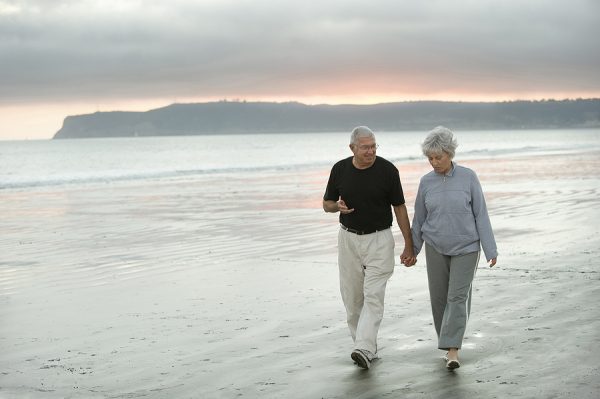When people spend hours at a time sitting still, they are just asking for trouble. I even tell people that “sitting is the new smoking,” because the health effects are similar.
Like smoking, prolonged periods of sitting increases the risk for heart disease, stroke, cancer and death. Both smoking and sitting also contribute to the development of type 2 diabetes, dementia and weakened bones.
Plus, when you sit for hours at a time it causes blood to pool in your legs. It slows down blood flow and causes it to become more viscous. This puts you at greater risk of developing blood clots. Because blood tends to pool in your legs and feet, that’s where you’re going to get the clots.
I compare it to “economy-class syndrome.” That’s what we call clotting problems that occur in airline passengers after several hours of flight.
The problem is that a clot can break loose and travel to your heart, lungs or brain where it can get stuck and block blood flow.
You might think that as long as you’re active when you aren’t sitting around, that you’ll offset the risk. But even people who regularly engage moderate to vigorous physical activity face an increased risk of a clot. It simply doesn’t offset the damage caused by long periods of sitting.
An Easy Way to Offset the Risks of Sitting
Research finds that normal blood flow to the legs becomes significantly impaired within an hour of sitting, and continues to decline over the next several hours. But guess what?
When people walk for just 10 minutes after a prolonged period of sitting, it restores normal blood flow.
This is one of the key reasons that I recommend you take a walk up and down the aisle every half hour or so when flying on a plane. But the same rule applies when you’re sitting at home – whether you are reading, watching TV, working at your computer or anything else that causes you to sit for long periods of time.
But taking a brief walk isn’t just better for blood flow. A new study from Medicine and Science in Sports and Exercise finds that taking a light walk every half hour also has an effect on blood sugar, blood pressure and mental health.
The study tested the results of walking one minute after 30 minutes of sitting and one minute after sitting for 60 minutes; or walking for five minutes after every 30 minutes of sitting and five minutes after every hour.
The winning regimen was to walk five minutes after every 30 minutes of sitting.
It reduced after meal blood sugar spikes by nearly 60%, and reduced blood pressure by four to five points. Additionally, all of the walking routines (except walking one minute every hour) improved mood and reduced fatigue.
That’s a lot of health benefits in a very short amount of time.
Your Body Was Made for Movement
You body wasn’t made to sit. It was made to walk and run. And we often fall woefully short on getting our steps in each day.
All you need to do is get up and do something that involves walking every half hour for five minutes. You can sweep or vacuum the floor. Do the dusting or laundry, or just start marching around the living room.
Better yet, get out of the house completely and do something you enjoy. Work in the garden, visit a neighbor, take the dog for a walk. Just do anything that gets you up and moving, and do it often throughout the day.
Sources:
Biswas A, Oh PI, Faulkner GE, Bajaj RR, Silver MA, Mitchell MS, Alter DA. Sedentary time and its association with risk for disease incidence, mortality, and hospitalization in adults: a systematic review and meta-analysis. Ann Intern Med. 2015 Jan 20;162(2):123-32.
Maddatu J, Anderson-Baucum E, Evans-Molina C. Smoking and the risk of type 2 diabetes. Transl Res. 2017 Jun;184:101-107.
Bailey DP, Hewson DJ, Champion RB, Sayegh SM. Sitting Time and Risk of Cardiovascular Disease and Diabetes: A Systematic Review and Meta-Analysis. Am J Prev Med. 2019 Sep;57(3):408-416.
Livingston G, Huntley J, Sommerlad A, Ames D, Ballard C, Banerjee S, Brayne C, Burns A, Cohen-Mansfield J, Cooper C, et al. Dementia prevention, intervention, and care: 2020 report of the Lancet Commission. Lancet. 2020 Aug 8;396(10248):413-446.
Yan S, Fu W, Wang C, Mao J, Liu B, Zou L, Lv C. Association between sedentary behavior and the risk of dementia: a systematic review and meta-analysis. Transl Psychiatry. 2020 Apr 21;10(1):112.
Tarantino U, Cariati I, Greggi C, Gasbarra E, Belluati A, Ciolli L, Maccauro G, Momoli A, Ripanti S, Falez F, Brandi ML. Skeletal System Biology and Smoke Damage: From Basic Science to Medical Clinic. Int J Mol Sci. 2021 Jun 21;22(12):6629.
Gobbo LA, Júdice PB, Hetherington-Rauth M, Sardinha LB, Dos Santos VR. Sedentary Patterns Are Associated with Bone Mineral Density and Physical Function in Older Adults: Cross-Sectional and Prospective Data. Int J Environ Res Public Health. 2020 Nov 6;17(21):8198.
Kunutsor SK, Dey RS, Laukkanen JA. Television viewing and venous thrombo-embolism: a systematic review and meta-analysis. Eur J Prev Cardiol. 2022 May 25;29(7):e239-e242.
Thosar SS, Bielko SL, Mather KJ, Johnston JD, Wallace JP. Effect of prolonged sitting and breaks in sitting time on endothelial function. Med Sci Sports Exerc. 2015 Apr;47(4):843-9. Trialduran AT, Friel CP, Serafini MA, Ipek E, Ceung YK, Diaz KM. Breaking Up Prolonged Sitting to Improve Cardiometabolic Risk: Dose-Response Analysis of a Randomized Cross-Over. Medicine & Science in Sports & Exercise. 2023. Epub ahead of print.






